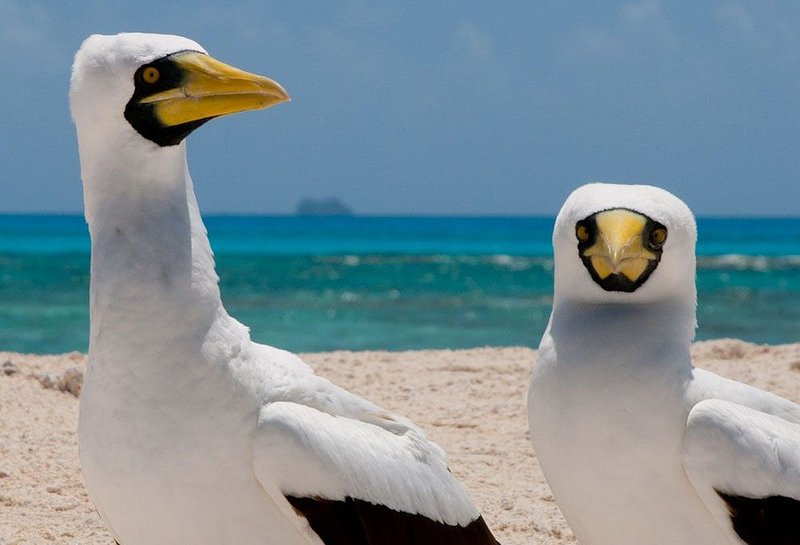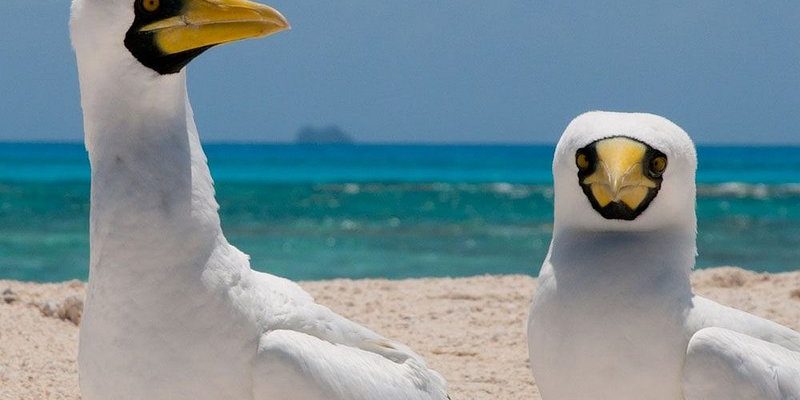
The Masked Booby, known scientifically as *Sula dactylatra*, is a remarkable seabird that captures the attention of birdwatchers and nature enthusiasts alike. With its striking appearance and fascinating behaviors, this bird isn’t just another feathered friend; it’s a master of the ocean skies. Imagine a bird that can soar gracefully over the waves, diving down to catch fish with precision. That’s the essence of the Masked Booby.
These birds are part of the booby family, which includes various species known for their unique hunting strategies and social behaviors. You might picture a group of them perched on rocky cliffs, looking out over the shimmering sea, ready to take flight at a moment’s notice. With their distinct mask-like facial markings and impressive wingspan, Masked Boobies are not just visually striking but also play a significant role in their ecosystem.
Let’s dive deeper into the world of the Masked Booby, exploring where they live, what they eat, and their fascinating behaviors. Whether you’re a dedicated birdwatcher or a casual nature lover, there’s plenty to discover about this incredible seabird.
Physical Characteristics
The Masked Booby is easily recognizable thanks to its distinct features. Adults typically boast a wingspan of about 5.5 to 6.5 feet, allowing them to glide effortlessly on ocean breezes. Their plumage is primarily white, which contrasts brilliantly with their dark brown wings and back. But what really stands out is their striking black “mask” that covers the eyes and extends to the beak—hence the name “Masked Booby.” This unique trait not only makes them easy to identify but also adds an air of mystery to their appearance.
When it comes to size, adult Masked Boobies measure around 29 to 35 inches in length. Their beaks are long and pointed, designed perfectly for catching fish. You might be surprised to learn that juveniles have a different look; they feature brown and white feathers that gradually change to the adult coloration as they mature. This transformation is just one of the many intriguing aspects of their life cycle.
One of the most fascinating features of the Masked Booby is their impressive diving capability. These birds are known for their spectacular hunting technique, where they plunge into the water from heights of up to 30 meters (about 98 feet). This behavior not only demonstrates their physical fitness but also their critical role in maintaining the balance of marine ecosystems.
Habitat and Distribution
You’ll find Masked Boobies primarily in tropical and subtropical ocean regions, including the Caribbean, Indian, and Pacific Oceans. They are most commonly spotted on islands and coastal areas, where they prefer nesting on rocky cliffs or sandy beaches. Their habitat is crucial for their breeding and feeding habits, as these locations provide ample access to fish without too much competition from other birds.
Interestingly, Masked Boobies are known to be quite sociable, often nesting in colonies with other seabird species. These colonies can sometimes be quite large, creating a lively atmosphere filled with the sounds of squawking and flapping wings. Within these colonies, they form strong pair bonds, often returning to the same nesting site year after year.
However, their choice of habitat is also vital for their survival. With rising sea levels and climate change threatening coastal ecosystems, the Masked Booby’s nesting sites are increasingly at risk. Conservation efforts are ongoing to protect these beautiful birds and their environments, ensuring future generations can appreciate these incredible seabirds.
Feeding Habits
The diet of the Masked Booby primarily consists of fish, particularly small species that swim near the ocean surface. They are skilled hunters, using their keen eyesight to spot schools of fish while soaring high above the water. When they identify a target, they dive steeply, plunging into the water with remarkable speed and agility to catch their prey.
What’s truly fascinating is how they can adjust their hunting techniques based on available food sources. During breeding seasons, when fish populations may fluctuate, Masked Boobies exhibit different foraging strategies to ensure they bring enough food back to their chicks. This adaptability is a testament to their survival skills.
Masked Boobies are also known to engage in cooperative hunting. You might think of them as a team of skilled fishermen, working together to drive schools of fish toward the surface. This behavior not only increases their chances of catching food but also strengthens their social bonds within the colony.
Breeding and Parenting
Breeding season for Masked Boobies typically occurs between March and September, depending on their location. During this time, you’ll notice males performing elaborate courtship displays to attract females. These displays can include aerial acrobatics, loud calls, and even presenting nesting materials. Once a pair forms, they work together to build their nest, often creating a simple scrape in the ground lined with sand and pebbles.
After laying one to three eggs, both parents share incubation duties, which lasts about 41 to 45 days. Once the chicks hatch, they are altricial, meaning they are born helpless and rely heavily on their parents for food and protection. This is where the teamwork really shines—both parents take turns feeding and caring for the chicks, bringing them fish and keeping them safe from predators.
As the chicks grow, they become more independent but remain dependent on their parents for several months. They learn to forage by watching their parents, a skill that is crucial for their survival. Eventually, when they are ready to fledge, the young Masked Boobies take their first flight, marking a significant milestone in their lives. This transition from helpless chicks to skilled hunters is nothing short of remarkable.
Conservation Status
While Masked Boobies are currently classified as a species of “Least Concern” by the IUCN, they still face threats that could impact their populations. These threats include habitat destruction, climate change, and human activities such as fishing and tourism. The loss of nesting sites due to rising sea levels and increased storm activity is particularly concerning.
Various conservation efforts are underway to protect the habitats of Masked Boobies and other seabirds. These efforts include creating marine protected areas, restoring nesting sites, and implementing regulations on fishing to ensure sustainable practices. Local communities and organizations play a pivotal role in these initiatives, raising awareness and advocating for the protection of these stunning seabirds.
It’s important to remember that the protection of Masked Boobies also contributes to the overall health of marine ecosystems. By taking steps to conserve their populations, we are also safeguarding the intricate web of life in our oceans. Each small action can lead to significant results in preserving these beautiful birds for future generations to admire.
Interesting Facts
Here are some fun and intriguing facts about the Masked Booby that you might not know:
- Social Birds: Masked Boobies are often found nesting in large colonies, which creates a lively social environment.
- Impressive Divers: They are known for their incredible diving abilities, reaching depths of up to 30 meters when hunting for fish.
- Long Lifespan: In the wild, Masked Boobies can live for over 20 years, showcasing their resilience and adaptability.
- Vocalizations: They are not shy about making noise; their calls can be heard from quite a distance, especially during the breeding season.
- Plumage Changes: Juvenile Masked Boobies undergo significant changes in their feather patterns as they mature into adults.
FAQ
What do Masked Boobies eat?
Masked Boobies primarily feed on small fish, which they catch using spectacular diving techniques. Their diet mainly consists of fish that swim near the surface of the ocean. They are known to adjust their hunting strategies based on the availability of food, ensuring that they can successfully feed themselves and their chicks.
Where can I find Masked Boobies?
You can find Masked Boobies in tropical and subtropical regions, primarily across the Caribbean, Indian, and Pacific Oceans. They tend to nest on rocky cliffs and sandy beaches, making coastal areas the best places to observe them in their natural habitat.
Are Masked Boobies social birds?
Yes, Masked Boobies are very social creatures. They often nest in large colonies, which can include many other seabird species. These colonies create a lively atmosphere where they engage in various social behaviors.
How do Masked Boobies breed?
During the breeding season, which generally occurs from March to September, males perform courtship displays to attract females. Once a pair forms, they work together to build a nest and share responsibilities for incubation and caring for their chicks.
What is the lifespan of a Masked Booby?
In the wild, Masked Boobies can live for over 20 years. Their longevity is a testament to their adaptability and the skills they develop throughout their lives.
What threats do Masked Boobies face?
Masked Boobies face various threats, including habitat destruction, climate change, and human activities like fishing and tourism. These factors can significantly impact their populations and nesting sites.
Are there conservation efforts for Masked Boobies?
Yes, there are several conservation efforts in place aimed at protecting Masked Boobies and their habitats. These include creating marine protected areas, restoring nesting sites, and advocating for sustainable fishing practices to help ensure the survival of these incredible seabirds.
What makes Masked Boobies unique?
Their striking facial markings, impressive diving skills, and strong social behaviors make Masked Boobies unique among seabirds. Their ability to adapt to their environment and work together as a colony adds to their charm and significance in marine ecosystems.
Can I see Masked Boobies in zoos or wildlife parks?
Masked Boobies are predominantly wild birds and are not commonly found in zoos or wildlife parks. However, certain wildlife sanctuaries focused on marine life may have programs for observing these magnificent seabirds in their natural habitats.

